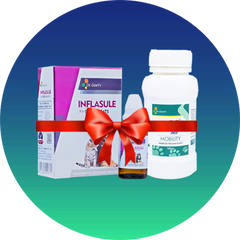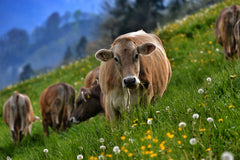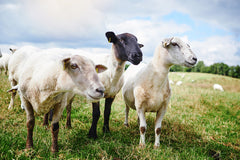
Efficacy of a Homeopathic complex and antibiotics in treatment of clinical mastitic cattle in North Gujarat
Efficacy of a Homeopathic complex and antibiotics in treatment of clinical mastitic cattle in North Gujarat
ABSTRACT:
This research is based on the field trial hence; all the treatments were randomly carried out in the field animals without selection but recorded properly. A total of 495 animals suffering from clinical mastitis were used for the study. All the animals were categorized according to their clinical conditions of udder as oedematous but not fibrosed, fibrosed, bloody milk and watery milk. All the affected animals had either one or more than one quarters involved. All the animals were basically treated with higher antibiotics with little success, therefore 361 animals out of 495 were treated with Tetasule@ a homeopathic medicine along with higher antibiotics as routine and rest 134 animals were considered as control but treated only with antibiotics. Out of 361 treated cases of clinical mastitis 345 (95.56%) cases recovered completely. All the animals in this treated group provided more than 90 % recovery rate. Maximum recovery was recorded in the cases having watery milk and mostly one or two quarters were affected followed by oedematous and non fibrosed, bloody milk and lastly fibrosed, where as in control group except oedematous significantly lower than (50%) recovery rates were observed.
INTRODUCTION:
Mastitis is recognized as one of the costliest disease all over the world affecting dairy animals and it is a persistent enigmatic problem in high yielding animals for years together. For over decades, antibiotic has been used to treat mastitic animals, however, it is a continuous major disease problem of the dairy industry (Smith and Hogan 1993). Mastitis is most common reason for antibiotic use in dairy cows and mastitogen have led to the development of resistance and failure of antibiotic therapy (Pachauri et al 2001). The current treands necessities the use of alternative therapy (Homeopathy) for the control of mastitis through enhancement of immune system of udder (Pachauri et al. 2001). Use of homeopathy in mastitis cases, is the great benefit in food producing animals and reduces the antibiotic residue in milk and milk products.
Keeping above facts in view the present study has been planned to evaluate the efficacy of Tetasule (a combination of homeopathic drugs) along with antibiotics to treat the various clinical fonn of mastitis in one group of cattle and only antibiotic therapy in another group of cattle having similar condition of udder in North Gujarat
MATERIAL AND METHOD
This research is based on the field trial hence; all the treatments were randomly carried out in the field animals without selection but recorded properly.
A total of 495 animals suffering from clinical mastitis were used for the study. All the animals were categorized according to their clinical conditions of udder as oedematous but not fibrosed, fibrosed, bloody milk and watery milk. All the affected animals had either one or more than one quarters involved.
All the animals were basically treated with higher antibiotics with little success, therefore 361 animals out of 495 were treated with Tetasule (Goel Vet Pharma, Chittorgarh, Rajasthan, India) a homeopathic medicine along with higher antibiotics as routine and rest 134 animals were considered as control but treated only with antibiotics.
As per schedule Tetasule has been given to treated group of animals in the morning and evening in fonn of liquid in a pack for 6 days. The composition of No.1 (used in morning) and No.2 (used in evening) has been given below. No treatment of Tetasule was given to control animals and observations were properly recorded.
It was observed that in 5 animals, though the recovery was noticed but it was not complete hence, the treatment was continued for 30 days till complete recovery. The documented hypothesis for homeopathic drug is that homeopathic medicine used in infection are not antibiotics but similibiotics (Similar to bacteria) which is capable of producing similar symptoms in patients as produced by bacteria and hence it may promise a new hope in cases where bacteria have become resistant to each and every known antibiotics. Homeopathy is a natural remedy to assist by stimulating body’s natural defenses of recovery and it can playa very vital role in successful rearing of animals.
One pack of Tetasule consists of two Bottles i.e. Tetasul No.1 and Tetasule No.2 with different composition of homeopathic preparation. Each was used in six divided doses of 5 ml in morning and evening respectively. The compositions of the medicines are as below.
TEATASULE NO. 1 USED IN THE MORNING FOR 6 DAYS
Apiswel- 200 Pecacuanha -200
Bryonia -200 Plytolacca -200
Chamcmila -200 Urtica -200 Calc carb Q.S.
TEATASULE NO.2 USED IN EVENING FOR 6 DAYS
Belladona 200 Hepersulph 200
Calcflour 200 Silica 200
Conum 200 Calc Carb Q.S.
Results and Discussion
Out of 361 treated cases of clinical mastitis 345 (95.56%) cases recovered completely. All the animals in this treated group provided more than 90 % recovery rate. Maximum recovery was recorded in the cases having watery milk and mostly one or two quarters were affected followed by oedematous and non fibrosed, bloody milk and lastly fibrosed, where as in control group except oedematous significantly lower than (50%) recovery rates were observed. These recovery rates were quite higher than recovery rates reported by Pachauri et al (1994) who recorded 73.33 % efficacy of homeopathic drugs and Upadhyay et al (1995) who reported 79.41 % to 84.62 % efficacy of combination of homeopathic drugs. In an other study Upadhyay and Sharma (1999) reported 80.95 % recovery in cases where fibrosis of udder was also present and relapsing of signs were not noticed till next 30 days
Acknowledgement
The Authors are thankful to Goel Vet Pharma, Chittorgarh, Rajasthan for providing medicines free of cost. Thank are also due to Farmers and field Veterinarians of north Gujarat region for their co- opration in this study, without their support such study would have not been possible.
References
1. Pachauri.S.P.; and Rajora, V.S.(1994). Indian J. Anim. Sci.64: 31-34.
2. Pachauri, S.P. (2000). Paper presented at National Seminar on Recent Advances in Livestock Development and their Implications held at College of Veterinary Sciences, Pantnagar, March 24-25.
3. Pachauri, S.P.; Singh, S.V. and Nauriyal, D.S. (2001).Indian Vet. Med. J. 25:317-321.
4. Smith, K.L.; and Hogan, J.S. (1993). Veterinary Clinicas of North America: Food Animal Practice.9: 489-498.
5. Upadhyay, A.K.; Rajora, V.S.; Pachauri.S.P.; and Gupta, G.C.;(1995). Indian Vet. Med. J. 19:65-67.
6.Upadhyay, A.K.and Sharma, S.N. (1999). Indian Vet. Med.J.23: 71-72.
Table-1. Showing the details of recovery percentage in various conditions of udder in animals treated with Antibiotic along with homeopathy
| Physical condition of udder | No. of animals treated | No. of animal responded | Recovery % |
|---|---|---|---|
| Oedematous and non fibrosed | 116 | 112 | 96.55 |
| Fibrosed | 100 | 93 | 93.00 |
| Blood in milk | 73 | 69 | 94.52 |
| Watery milk | 72 | 71 | 98.61 |
| Total | 361 | 345 | 95.56 |
Table-2. Showing the details of recovery percentage in various conditions of udder in animals treated with Antibiotic only.
| Physical condition of udder | No. of animals treated | No. of animal responded | Recovery % |
|---|---|---|---|
| Oedematous and non fibrosed | 36 | 25 | 69.44 |
| Fibrosed | 44 | 16 | 36.66 |
| Blood in milk | 32 | 15 | 46.87 |
| Watery milk | 22 | 6 | 27.27 |
| Total | 134 | 67 | 50.00 |
Keywords: Homeopathy, Clinical Mastitis, Antibiotic, Treatment, Cattle, Efficacy.
Research by -
Chandel B S, Dadawala A.I, Chauhan H. C*, Parsani H.R and Pankajkumar College of Veterinary Science & Animal Husbandry S D A U Sardarkrushinagar-385506







